If I had a dollar for every cracked windshield I’ve seen in my 30 years, I’d have retired to the Upper Peninsula by now.
Back in the 90s, when I first started detailing cars in my old garage, a windshield crack was just another “battle scar.” People would say, “Ah, it’s fine, Mike. I’ll fix it later.” Fast forward a few weeks — that small crack turned into a spider web across the entire windshield. Then came the regret, and a repair bill three times higher.
Today, car glass technology has changed. We’ve got rain sensors, lane assist cameras, and heads-up displays embedded right into the glass. But the truth hasn’t changed one bit — driving with a cracked windshield is not safe, especially on Michigan’s unpredictable roads.
So let’s talk about why that crack matters, when it’s fixable, when it’s not, and what every Michigan driver should know before they hit I-75 with a chip in their line of sight.
Why This Topic Matters
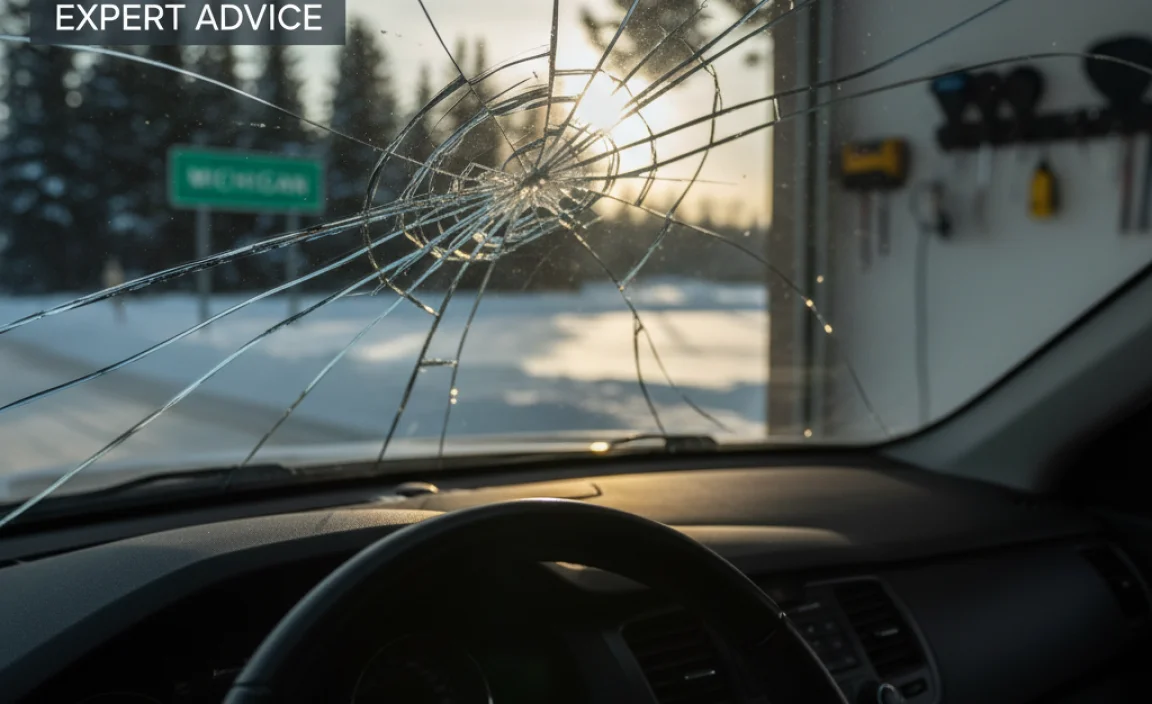
Most folks think a crack is just cosmetic — like a dent in the bumper. But your windshield isn’t just glass; it’s a critical safety component.
Here’s why it matters:
- It supports up to 60% of your car’s roof strength during a rollover.
- It’s designed to keep you inside the vehicle during a crash.
- It helps deploy airbags correctly.
So when you’ve got a crack, even a small one, it’s not just about visibility — it’s about your safety, structure, and security.
Understanding Windshield Cracks: Not All Are Created Equal
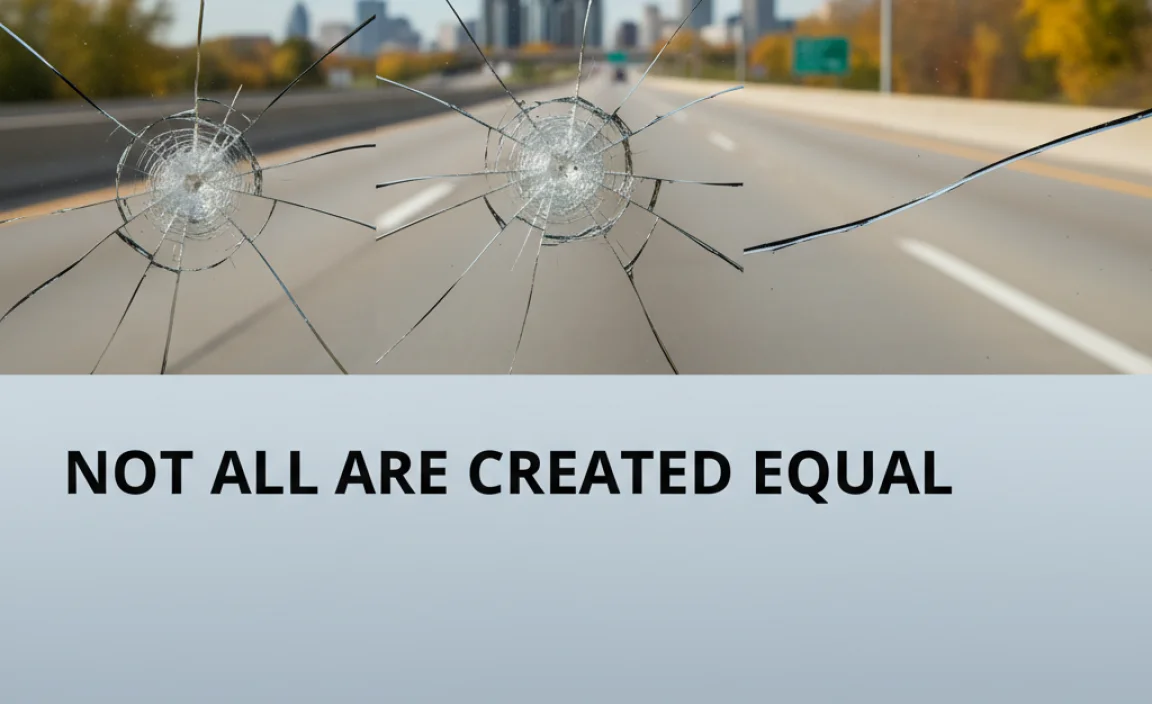
I’ve seen everything from tiny “bullseye” chips to full-on “spider web” cracks across the glass.
Here’s a quick breakdown of the common types:
Bullseye Crack
A round chip caused by a rock or debris. It looks like a small circle — usually fixable if caught early.
Star Break
Cracks radiate from the impact point like a star. These tend to spread quickly, especially in cold weather.
Spider Web Crack
Multiple cracks spreading out from a single point — looks like a spider web (hence the name). Usually means full replacement time.
Edge Crack
Starts near the edge of the windshield. Dangerous because it compromises the entire structure.
Stress Crack
No impact point. Caused by extreme temperature changes (hello, Michigan winters!).
Is It Actually Safe to Drive with a Cracked Windshield?
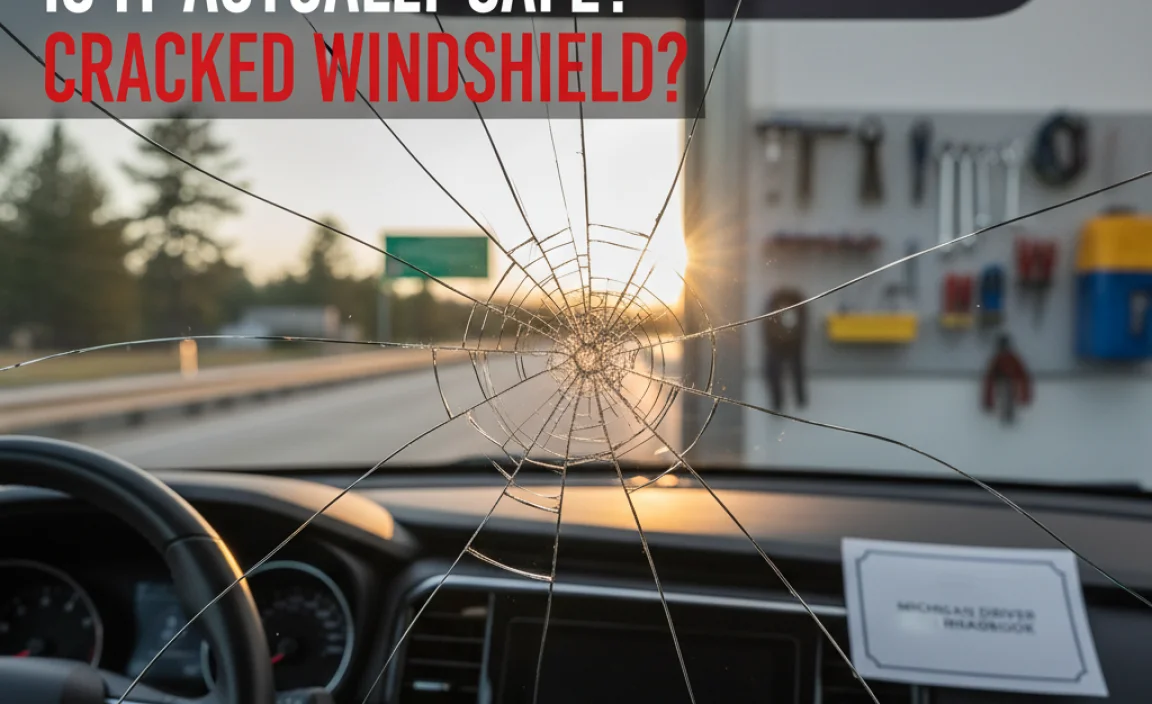
Short answer: No, not really.
Long answer: It depends on the size, location, and depth of the crack — but even then, you’re gambling with your safety.
Here’s how I break it down for customers at my shop:
| Situation | Safe to Drive Temporarily? | My Advice |
| Small chip under 1 inch, outside driver’s view | Maybe | Get it repaired ASAP before it spreads. |
| Crack longer than 6 inches | ❌ No | Replace immediately. It’s unsafe. |
| Crack near windshield edge | ❌ No | Structural risk. Replace it. |
| Crack in driver’s line of sight | ❌ No | Repair can distort view even after fix. |
| Multiple cracks or spreading lines | ❌ No | Full replacement needed. |
The Michigan Factor: Cold Weather, Salt, and Potholes
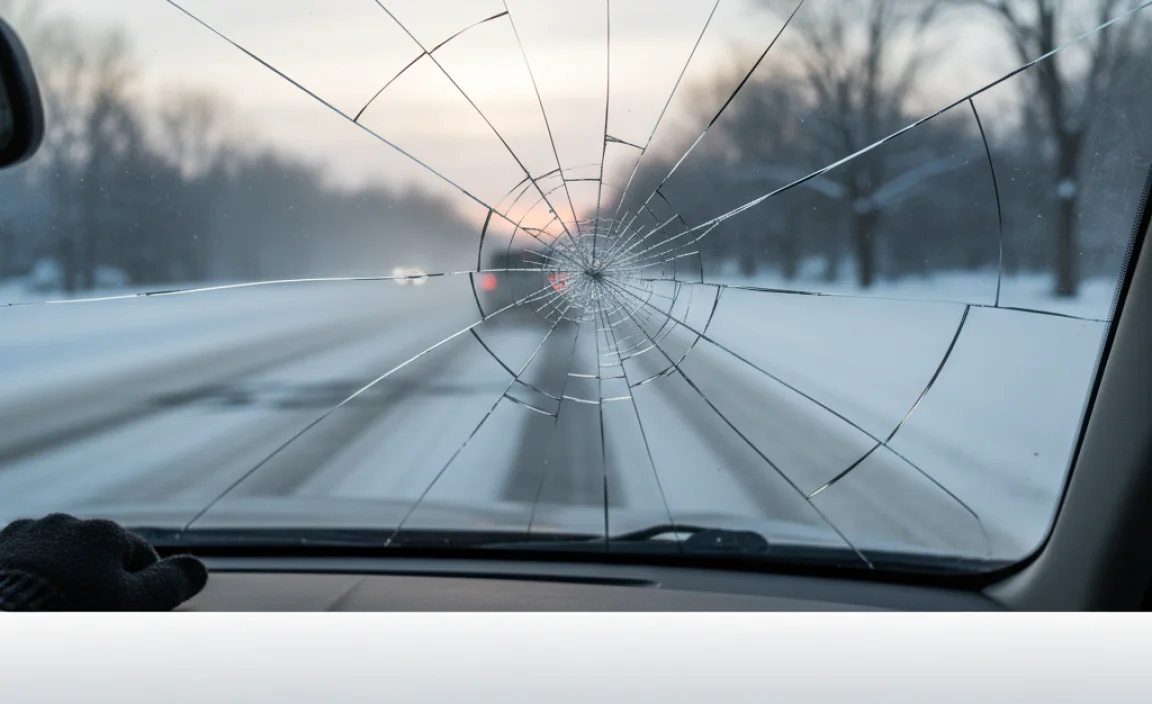
I’ve lived in Michigan my whole life — and if there’s one thing that’s harder on your car than time, it’s a Michigan winter.
Between salt, snow, and potholes deep enough to hide a tire, your windshield takes a beating.
Here’s how Michigan’s climate makes things worse:
- Temperature swings: Freezing nights and sunny days cause the glass to expand and contract — making cracks grow.
- Road salt: It corrodes the metal frame around the glass, weakening the seal.
- Potholes: That jolt you feel? It’s shaking your entire windshield. If it’s already cracked, that vibration spreads it faster.
A simple 1-inch chip can turn into a 12-inch crack overnight when temperatures drop below 20°F. I’ve seen it happen hundreds of times.
The Legal Side: Michigan Windshield Laws
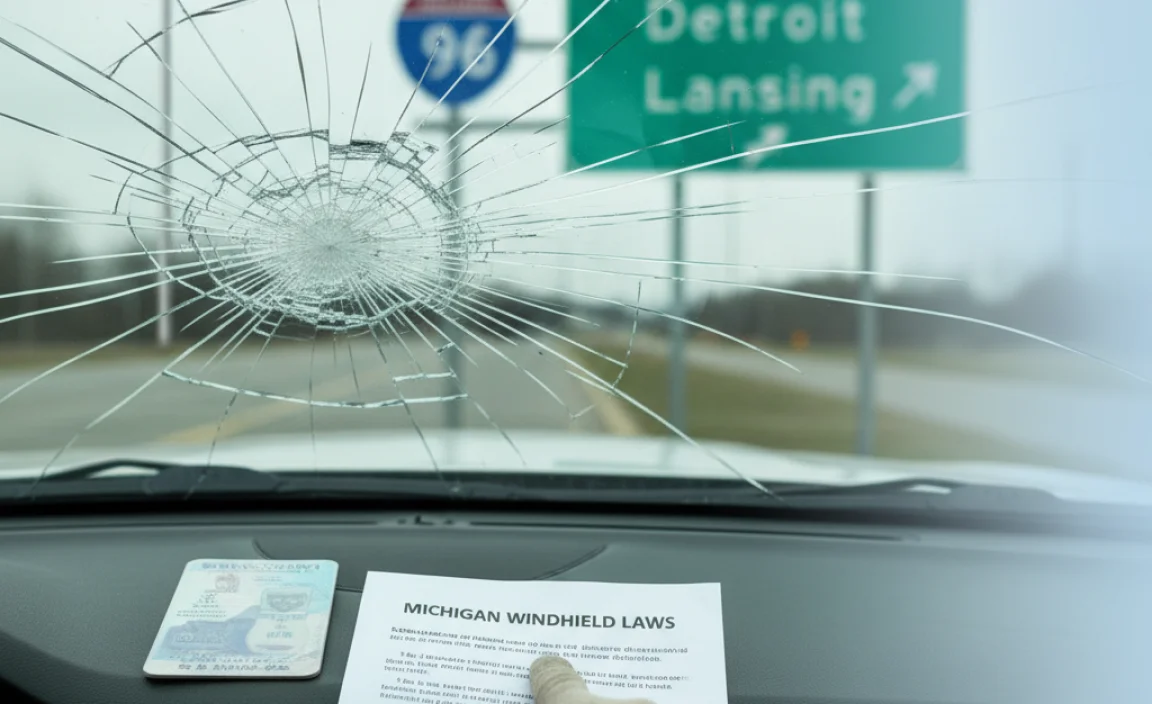
Now let’s talk about what’s legal — because yes, it’s technically illegal in Michigan to drive with certain windshield damage.
Michigan law (MCL 257.708b) states that a vehicle must not have any obstruction in the driver’s view that impairs visibility.
That means:
- A crack directly in the driver’s line of sight can get you a ticket.
- Cracks that affect the wiper area may also fail inspection (if required).
You might not get pulled over just for it, but if you’re stopped for another reason, that crack could cost you.
How a Cracked Windshield Compromises Safety
Let’s get into the technical side — simplified for everyday folks.
- Weakened Structure – Your windshield works with the roof and pillars to form the car’s safety cage. A crack weakens that system.
- Airbag Malfunction – Airbags often bounce off the windshield when deployed. A weak windshield can cause misfires or failure.
- Reduced Visibility – Cracks scatter light, especially at night or during rain. That glare can blind you for a split second — which is all it takes for an accident.
- Ejection Risk – In a severe crash, a compromised windshield can shatter more easily, increasing risk of being thrown from the vehicle.
Bottom line: It’s not worth the risk.
Repair vs. Replacement: What’s Best for You?
This is where a lot of drivers get confused. So here’s the straight talk:
When Repair Works
- Crack smaller than 6 inches
- No cracks touching the edges
- No damage in the driver’s direct view
- Only one or two chips
When You Need a Full Replacement
- Cracks over 6 inches
- Damage near the edges
- Multiple chips
- ADAS systems affected (lane assist, auto wipers, etc.)
Cost Breakdown (Average in Michigan)
| Type | Estimated Cost | Insurance Coverage |
| Small chip repair | $60–$100 | Usually 100% covered |
| Full windshield replacement | $250–$500 (standard) | Partial/full coverage with glass deductible |
| ADAS recalibration (after replacement) | $150–$300 | Some policies cover this |
Pro Tip:
Many insurance policies cover chip repair for free — because it’s cheaper than paying for a replacement later.
DIY Windshield Repair Kits – Worth It?
I get this question a lot: “Mike, can I just use one of those repair kits from AutoZone?”
Well, here’s the truth — sometimes yes, mostly no.
Those kits are fine for tiny chips if you know what you’re doing. But most people don’t clean the impact area properly or overfill the resin.
Result? You end up sealing in dirt, moisture, and air bubbles — and the crack still spreads.
If you must DIY, here’s my pro checklist:
- Clean the area thoroughly with rubbing alcohol.
- Avoid direct sunlight during repair.
- Don’t overfill the resin.
- Let it cure for at least 30 minutes.
- Avoid washing the car for 24 hours.
Still, nothing beats professional equipment — we use vacuum injectors that pull out trapped air before sealing. That’s something a $15 kit can’t do.
Pro Tips from 30 Years in the Shop
Here are a few hard-earned lessons I’ve picked up along the way:
✅ Pro Tip #1: Avoid Sudden Temperature Changes
Never pour hot water on a frosty windshield — it’ll make cracks grow instantly.
✅ Pro Tip #2: Use the Right Glass Cleaner
Skip the ammonia-based stuff (like regular Windex). It can weaken tint and rubber seals.
✅ Pro Tip #3: Park Smart
Avoid parking under trees or construction zones — falling debris is the #1 cause of glass chips in Michigan.
✅ Pro Tip #4: Get Calibrated
If your car has lane assist, forward collision warning, or auto wipers, always get ADAS recalibration after glass replacement.
✅ Pro Tip #5: Fix It Early
A chip costs less than a tank of gas to fix. A crack costs a weekend and a few hundred bucks. Your call.
Key Takeaways
Summary:
- Small cracks can compromise safety.
- Michigan’s weather worsens cracks quickly.
- Repairs are affordable — replacements, not so much.
- Always check insurance coverage.
- Don’t delay — early action saves money and lives.
Common Myths About Cracked Windshields
Let’s bust a few myths I hear all the time:
Myth #1: “If it’s small, it won’t spread.”
→ Wrong. Temperature, vibration, and time always make it worse.
Myth #2: “A repair makes it as strong as new.”
→ Not quite. It’s safer, yes — but it’ll never be exactly as strong as OEM glass.
Myth #3: “I’ll wait until inspection.”
→ By then, it might be too late — you’ll end up replacing it entirely.
Myth #4: “Tint hides cracks.”
→ Nope. Cracks show through, and tinting damaged glass can actually make things worse.
The Future of Windshields: Smarter, Stronger, Pricier
When I started, a windshield was just glass. Now it’s a sensor hub — housing rain detectors, cameras, and even AR projections.
That’s great for safety, but it also means replacements are more complex (and expensive).
Looking ahead, I see two big trends:
- Self-healing glass – already in testing by BMW.
- AI calibration systems – adjusting ADAS automatically after glass changes.
Until then, though, a cracked windshield is still a cracked windshield — and safety comes first.
FAQs
- Can I get pulled over for a cracked windshield in Michigan?
Yes. If it obstructs your view or poses a safety hazard, you can get cited. - How fast do windshield cracks spread?
Depends on temperature and vibration — but often within days or weeks in Michigan’s climate. - Does car insurance cover windshield replacement?
Most comprehensive plans do. Many even offer free chip repair to prevent full replacements. - Can I drive to work with a small crack?
Temporarily, yes — but avoid highways or rough roads until it’s fixed. - How long does a professional replacement take?
Usually about 60–90 minutes, plus an hour for adhesive curing.
A Personal Story to Wrap It Up
A few winters back, a young couple came into my shop with a small chip on their Toyota RAV4. They said, “We’ll fix it after our trip up north.”
A week later, they called from Gaylord. The chip had spread edge-to-edge after one icy night. They had to drive home with a fractured windshield, nervous the whole way.
That’s when it hit me — people underestimate this simple piece of glass.
Your windshield is your first line of defense on the road. Don’t gamble with it. Fix it while it’s small, before it becomes a safety hazard or a bigger bill.
Conclusion
After three decades in this business — from buffing chrome bumpers in the 80s to replacing Tesla Model 3 windshields today — one lesson holds true:
A cracked windshield isn’t just broken glass. It’s a broken promise of safety.
So if you’re in Sterling Heights, Detroit, or anywhere in Michigan — don’t wait until that crack grows. Visit a certified shop, ask about your insurance coverage, and get it fixed right.
And if you ever want honest advice or step-by-step guides, stop by TheCarGuider.com